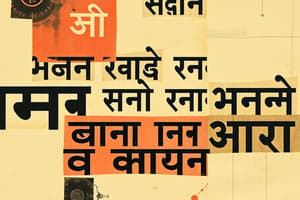Podcast
Questions and Answers
What is the primary script used to write Hindi?
What is the primary script used to write Hindi?
- Arabic script
- Latin script
- Cyrillic script
- Devanagari script (correct)
Which of the following is a standard form of Hindi?
Which of the following is a standard form of Hindi?
- Bhojpuri
- Braj Bhasha
- Khari Boli (correct)
- Awadhi
Hindi has significant vocabulary influence from which language?
Hindi has significant vocabulary influence from which language?
- German
- Latin
- Sanskrit (correct)
- Japanese
What is the grammatical order of sentences in Hindi?
What is the grammatical order of sentences in Hindi?
How many people approximately speak Hindi?
How many people approximately speak Hindi?
Flashcards are hidden until you start studying
Study Notes
Overview of Hindi
- Hindi is an Indo-Aryan language primarily spoken in India.
- It is one of the 22 scheduled languages of India and is the official language of the Indian government.
Script
- Hindi is written in the Devanagari script, which consists of 48 characters.
- The script is phonetic, meaning each character represents a sound.
Dialects
- Hindi has several dialects, including:
- Khari Boli: The standard form of Hindi.
- Braj Bhasha: Spoken in the Braj region of Uttar Pradesh.
- Awadhi: Predominantly spoken in the Awadh region of Uttar Pradesh.
- Bhojpuri: Spoken in the Bhojpuri region, parts of Bihar, and Uttar Pradesh.
Vocabulary
- Hindi vocabulary has a significant influence from:
- Sanskrit: The classical language of India.
- Persian and Arabic: Due to historical invasions and trade.
- English: Increasing influence in modern times.
Grammar
- Hindi is a subject-object-verb (SOV) language.
- Gender: Nouns have genders (masculine and feminine).
- Tense: Verbs conjugate according to tense (present, past, future).
Phonetics
- Hindi has a rich sound system with 11 vowels and 33 consonants.
- It includes aspirated and unaspirated consonants.
Usage
- Hindi is spoken by approximately 500 million people.
- It serves as a lingua franca in northern and central India.
Cultural Significance
- Hindi is central to Indian literature, cinema (Bollywood), and music.
- The language is celebrated on Hindi Diwas, observed on September 14 each year.
Challenges
- Hindi faces competition from other regional languages.
- There is ongoing debate about the standardization of the language and script reforms.
Overview of Hindi
- Hindi is an Indo-Aryan language widely spoken in India, designated as one of the country's 22 scheduled languages.
- It serves as the official language of the Indian government, facilitating communication at national levels.
Script
- Written in the Devanagari script, which comprises 48 characters.
- The phonetic nature of Devanagari allows each character to represent a distinct sound, promoting accurate pronunciation.
Dialects
- Features various dialects, with notable ones including:
- Khari Boli: Recognized as the standard form of Hindi.
- Braj Bhasha: Predominantly spoken in the Braj region of Uttar Pradesh.
- Awadhi: Major dialect in the Awadh region of Uttar Pradesh.
- Bhojpuri: Common in the Bhojpuri-speaking areas of Bihar and Uttar Pradesh.
Vocabulary
- Rich vocabulary influenced significantly by:
- Sanskrit: The ancient and classical language.
- Persian and Arabic: Adoption due to historical invasions and cultural exchange.
- English: Growing impact in contemporary contexts, reflecting modernization.
Grammar
- Utilizes a subject-object-verb (SOV) sentence structure, which differentiates it from many Western languages.
- Gender classification is vital, as nouns are categorized as masculine or feminine.
- Verbs are conjugated to express various tenses, including present, past, and future.
Phonetics
- Comprises a complex sound system with 11 vowels and 33 consonants, enhancing expressiveness.
- Differentiates between aspirated and unaspirated consonants, contributing to its phonetic richness.
Usage
- Approximately 500 million speakers, making it one of the most spoken languages worldwide.
- Functions as a lingua franca, especially in northern and central regions of India, facilitating inter-regional communication.
Cultural Significance
- Plays a central role in Indian literature, particularly noted in Bollywood cinema and music.
- Hindi Diwas, celebrated on September 14 annually, honors the language and its cultural importance.
Challenges
- Faces competition from regional languages, which may impact its prevalence in various areas.
- Ongoing debates regarding language standardization and potential script reforms reveal the evolving nature of Hindi.
Studying That Suits You
Use AI to generate personalized quizzes and flashcards to suit your learning preferences.




